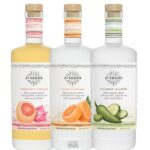There is a wonderful article by Douglas Van Praet in Fast Company about metaphors. WHY METAPHORS BEAT THE SNOT OUT OF FACTS WHEN IT COMES TO MOTIVATING ACTION. Doug spoke at a Wine Marketing Exchange Conference two years ago and his book, Unconscious Branding is filled with great insights and ideas for marketing professionals.
Metaphors are a powerful marketing tool often misunderstood. You can spend a lot of time and energy writing elaborate brochures that factually explain how your product will protect your clients products by sealing in freshness, but a life-sized safe at a trade show anchors that idea immediately. The metaphor of the safe beats the 10 page brochure to quickly explain the idea of sealing in and protecting something.
The metaphor is a powerful tool because we learn through our feelings, not through facts. Science is showing that you can learn from metaphor even more than facts. Neural circuits don’t distinguish between the real and metaphorical. In fact the brain is like a metaphor. Read Doug’s article to learn more about the science.
Here are some practical tips on how to think about using metaphor in marketing.
How to Use Metaphor in Marketing
Trade Shows: What can you bring to a trade show event that would symbolically represent your key message? Imagine you sell software that is flexible and adaptable. Perhaps it offers client a new advantage. Instead of having detailed booklets on the technology, what if you bring gymnasts or yoga masters to the booth to demonstrate the key message around flexibility? The audience will remember your key message through the metaphor far greater than if you distribute a white paper. I am not arguing that you don’t need the white paper, but the metaphor of flexibility can be communicated effectively through a person demonstrating that idea.
Direct Mail: Imagine if you want to reach 5,000 businesses to explain one key differentiation that your business or brand brings to the market. You want just one idea to penetrate so you can get their attention and communicate your value proposition. Words will be ineffective alone, and a metaphor can help. Staples mailed to office managers at 5,000 businesses an easy button that represented, metaphorically, how simple it is to do business with them. They told their story without words – but with a button you just push. Simple. Clear. Boom.
Advertising: Advertising professionals understand that you can’t expect a consumer to tell you what they feel or how an ad motivates them. You have to watch what they do and see their behavior. Metaphors, when employed properly are powerful tools to communicate a message of strength -Own a Piece of the Rock (Prudential) or You Are In Good Hands (Allstate). Ads don’t have to show the actual product you sell but can communicate the feeling you get working with your business. Prudential and Allstate sell various forms of financial and insurance products, but what they are really selling is the feeling of safety, security and protection. It is the emotional connection that counts, not a factual description of their product.
The ad can’t deliver the details of what a company sells as effectively as they can communicate how you will feel as a client.
Metaphor, Analogy and Similes
Marketing is about communicating benefits. You can produce a ten-page document that explains the reason and logic behind the things you sell. With rational arguments, you can outline a theme, a theory or a thesis that describes your benefit.
But I’ll take a nice, fat juicy metaphor any day to own a position in the mind of my customer.
Need help, metaphorically speaking? Call me.



